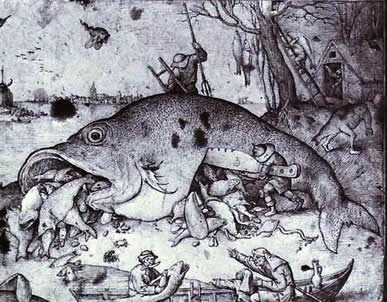博文
nature: 绘画风格的稀疏编码
|||
neuron: 经典感受野+非经典感受野=稀疏 )
稀疏编码的思想光芒甚至对神经科学产生了深远影响,如静息网络的研究(请看我的早期博文:
最近,有计算科学家用它来分辨文艺复兴时期最重要画家 老布鲁格尔(Pieter Bruegel the Elder)作品的真伪,让我们看到稀疏编码的又一应用:对艺术风格的量化。

图1. 稀疏编码,解构老布鲁格尔的画风
这篇发表在nature上的文章,报道了Hughes的一个工作(该工作发表在近期的PNAS上)。Hughes他们用老布鲁格尔作品的一部分构建“布鲁格尔空间模式字典”。老布鲁格尔的真迹,用“模式字典”里的寥寥几笔就可以表达,而如果不是老布鲁格尔的真迹,则会变得繁复不堪。
大家知道,老布鲁格尔是十七世纪鲁本斯和林布兰特画风的先驱。他的画迷众多,他的模仿者更多。个人最喜欢的就是这幅:Big Fish Eat Little Fish

Hughes他们的这个工作很有艺术觉悟。不过,个人觉得,区分一家之作的真假有点太过单一,区分多家肯定很难。比如风格独特的蒙德里安 (Piet Mondrian),这位老哥是以几何图形为绘画的基本元素。如这幅《百老汇爵士乐》:

Broadway Boogie-Woogie 1943
如果用稀疏编码之,估计就剩横竖了。不管如何,稀疏编码的魅力,从这个工作里,可见一斑!
nature杂志信息:
Applied mathematics: The statistics of style
Bruno A. Olshausen & Michael R. DeWeese
Abstract
Top of pageAbstractA mathematical method has been developed that distinguishes between the paintings of Pieter Bruegel the Elder and those of his imitators. But can the approach be used to spot imitations of works by any artist?
PNAS杂志信息:
Quantification of artistic style through sparse coding analysis in the drawings of Pieter Bruegel the Elder
Hughes et al.
Abstract
Recently, statistical techniques have been used to assist art historians in the analysis of works of art. We present a novel technique for the quantification of artistic style that utilizes a sparse coding model. Originally developed in vision research, sparse coding models can be trained to represent any image space by maximizing the kurtosis of a representation of an arbitrarily selected image from that space. We apply such an analysis to successfully distinguish a set of authentic drawings by Pieter Bruegel the Elder from another set of well-known Bruegel imitations. We show that our approach, which involves a direct comparison based on a single relevant statistic, offers a natural and potentially more germane alternative to wavelet-based classification techniques that rely on more complicated statistical frameworks. Specifically, we show that our model provides a method capable of discriminating between authentic and imitation Bruegel drawings that numerically outperforms well-known existing approaches. Finally, we discuss the applications and constraints of our technique.
https://blog.sciencenet.cn/blog-390719-297922.html
上一篇:neuron: 经典感受野+非经典感受野=稀疏
下一篇:脑中的暗能量